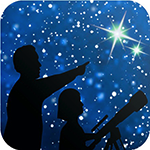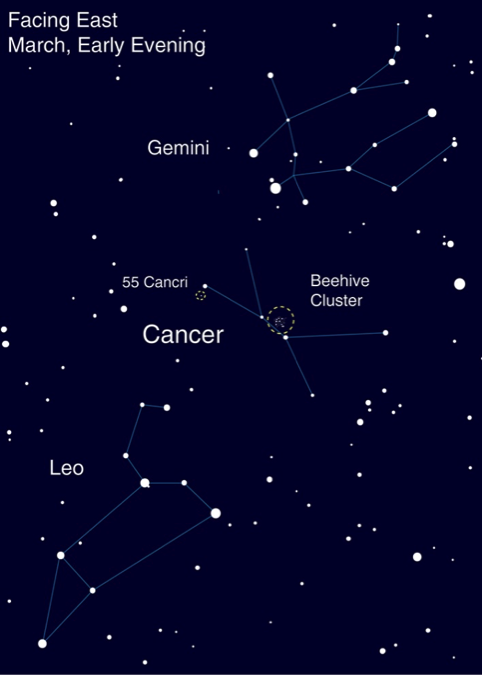Cancer the Crab is a dim constellation, yet it contains one of the most beautiful and easy-to-spot star clusters in our sky: the Beehive Cluster. Cancer also possesses one of the most studied exoplanets: the superhot super-Earth, 55 Cancri e.
Find Cancer’s dim stars by looking in between the brighter neighboring constellations of Gemini and Leo. Don’t get frustrated if you can’t find it at first, since Cancer isn’t easily visible from moderately light polluted areas. Once you find Cancer, look for its most famous deep-sky object: the Beehive Cluster! It’s a large open cluster of young stars, three times larger than our Moon in the sky. The Beehive is visible to unaided eyes under good sky conditions as a faint cloudy patch, but is stunning when viewed through binoculars or a wide-field telescope. It was one of the earliest deep-sky objects noticed by ancient astronomers, and so the Beehive has many other names, including Praesepe, Nubilum, M44, the Ghost, and Jishi qi. Take a look at it on a clear night through binoculars. Do these stars look like a hive of buzzing bees? Or do you see something else? There’s no wrong answer, since this large star cluster has intrigued imaginative observers for thousands of years.
55 Cancri is a nearby binary star system, about 41 light years from us and faintly visible under excellent dark sky conditions. The larger star is orbited by at least five planets including 55 Cancri e, (a.k.a. Janssen, named after one of the first telescope makers). Janssen is a “super-earth,” a large rocky world 8 times the mass of our Earth, and orbits its star every 18 hours, giving it one of the shortest years of all known planets! Janssen was the first exoplanet to have its atmosphere successfully analyzed. Both the Hubble and recently-retired Spitzer space telescopes confirmed that the hot world is enveloped by an atmosphere of helium and hydrogen with traces of hydrogen cyanide: not a likely place to find life, especially since the surface is probably scorching hot rock. The NASA Exoplanet Catalog has more details about this and many other exoplanets at bit.ly/nasa55cancrie.
How do astronomers find planets around other star systems? The Night Sky Network’s “How We Find Planets” activity helps demonstrate both the transit and wobble methods of exoplanet detection: bit.ly/findplanets. Notably, 55 Cancri e was discovered via the wobble method in 2004, and then the transit method confirmed the planet’s orbital period in 2011!
Want to learn more about exoplanets? Get the latest NASA news about worlds beyond our solar system at nasa.gov.
Artist concept of 55 Cancri e orbiting its nearby host star. Find details from the Spitzer Space Telescope’s close study of its atmosphere at: bit.ly/spitzer55cancrie and the Hubble Space Telescope’s observations at bit.ly/hubble55cancrie Credit: NASA/JPL-Caltech
Look for Cancer in between the “Sickle” or “Question Mark” of Leo and the bright twin stars of Gemini. You can’t see the planets around 55 Cancri, but if skies are dark enough you can see the star itself. Can you see the Beehive Cluster?



